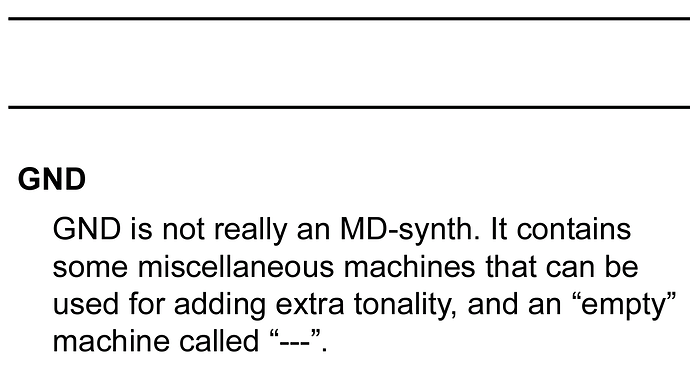HTML manuals is an idea that has been brought up here at the office too. Not sure what will happen yet, but yes, its definetly a good idea to make it easier to navigate the documentation.
Im sorry to say, but a french version of the OT MKII manual seems very unlikely at the moment.
In a perfect future world I would like to have all our manuals translated to a number of languages. I’ll do what I can to push for this to happen but I cant really promise anything. But I hear you.
Hey Eangman,
Seems the Model:Samples manual description of the lfo mul parameter is missing the info that “x” is tempo synced and I assume there’s a dot for fixed, not sure about the later because I don’t have one and it’s not in the manual. 

Yes it is indeed missing. Will fix. Good catch 
Could it make sense to add this to the A4 manual? Maybe in Appendix A or so. I don’t think it’s currently mentioned.
I recently spent some time trying to figure this out myself ![]() .
.
Hmm I will have to have a look at this one. Not totally sure what to do with this. I need to investigate the issue a bit more before I take any action. Thanks for bringing it up 
Octatrack manual : Not sure if default crossfader / scenes midi out channel is explained somewhere.
Incoming MIDI message automatically routed to same MIDI output
That NOTE LEN = 0 tip :
Octatrack Tips & Tricks (OT Tips)
What I find very irritating is that (at least in the OT manual) abbreviations are not “spelled out” and some of them are so cryptic that I don’t find where they are coming from.
Example: ANLG on the AMP SETUP page. I mean I understand what it does (that’s totally clear from the text), but there is nowhere in the text explained what ANLG stands for. ANALOG? Doesn’t really make sense for “restart from current level”. What else?
Maybe it’s just me, but remembering the meaning of random looking 4-chars-abbrevs is quite hard.
Oh come on… We gotta leave it at least somewhat cryptic…
The cruel thing is: it looks like it’s something simple and I’m just too stupid to solve the riddle. That’s nagging in the back of my mind the whole day long … I want my zen-like peace back 
I think this is by far my favorite, from Monomachine manual. 

Honestly not even I understand what ANLG is  Well, I guess it stands for Analog, but not sure why it is called that… standard analog behavior perhaps… I have to ask someone who was around when they made this choice.
Well, I guess it stands for Analog, but not sure why it is called that… standard analog behavior perhaps… I have to ask someone who was around when they made this choice.
The reason why you see quite a lot these abbreviations in the text is that it is the UI name/setting of that parameter and if it is not written as it is in the UI, it will be very difficult to understand exactly what the text is talking about.
Nowadays I do my best to describe the abbreviation though. An example from the Digitone manual…
“AENR Amp envelope reset sets the amp envelope behavior”
Haha, awesome. I see it as analog meaning continuous as in it doesn’t reset, but I don’t know if that makes complete sense…
Here’s a good one that @sezare56 has pointed out, see the loop? ![]()
From pg 17:
There’s a few more quirks I’ve noticed but haven’t written them down, next time I see them I’ll post them here…
AER? ![]()
It’s called “analog” because it replicates classic analog envelope behaviour, where they don’t reset to zero when triggered ![]()
![]() I still have no idea why this machine was included… is it even useful for anything?
I still have no idea why this machine was included… is it even useful for anything?
I spent several years trying to explain the envelope thing to Korg…
Basically it is just for when you have had a busy session and just want a little peace and quiet, load up each track with GND “-“ lay out your trigs and bliss out to some proper minimal ![]()
Edit: Joking aside could be useful when switching kits for silencing certain tracks only?
MD’s GND “—” can be useful, not sure about MnM’s (apparently lfo’s per track, no mute groups, no CTR ALL?).
Gnd “---”
The only thing I can think of is if you need more channels to sequence MIDI… maybe if you have a sweet GM module and want to get 12 channels rockin’ 

